The front door is the business card of the owner. If its outer surface is an element of the external decoration of the dwelling, then the decoration of the entrance door from the inside is done not for people passing by, but exclusively for oneself. The new door does not require finishing, and the used one, but still quite strong door leaf needs repair, which can be done by hand.
Methods for finishing the entrance door from the inside
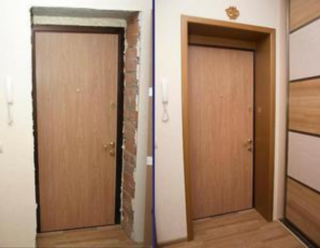
The presence of a large number of finishing materials will help give the iron door the look of a classic wooden model, and make the plastic door leaf look like, for example, marble.
The following technological processes are used for interior decoration of entrance doors.
- upholstery;
- staining;
- sheathing.
It is quite possible that finishing the entrance door from the inside will require solving the issues of sound insulation and insulation.
Upholstery
Upholstery of the inner side of the entrance door with soft materials has recently found a second wind. This is due to the appearance on the market of artificial leather substitutes (vinyl leather, nitro leather, etc.). The popularity of soft substitutes for natural leather is due to its excellent consumer qualities:
- low price;
- a large number of textures and colors;
- long service life, etc.
Artificial leather has serious drawbacks - it ignites quickly and is easily damaged by sharp objects.
Dyeing
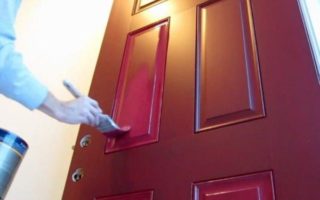
Painting is the simplest way of finishing the inner surface of an outer door, allowing you to quickly and without large financial costs transform the latter beyond recognition.
- Oil paints have good adhesion to metal and wood. The glossy surface is resistant to mechanical stress and lasts a long time. The disadvantage is long drying time.
- Acrylic and alkyd enamels are applied to any surface, dry quickly, and hold a glossy shine for a long time.
- Nitrocellulose paints are used only for painting internal surfaces.
The negative side of staining is that it is impossible to equip sound insulation and additional insulation.
Sheathing
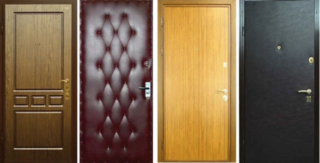
The cladding of the inner surface of the entrance door with hard materials has recently become widespread. This method has no obvious disadvantages. Among the advantages are:
- large range (material, color, texture, etc.);
- long service life;
- the possibility of arranging sound and heat insulation;
- easy maintenance, etc.
For cladding, the following materials are used:
- natural wood;
- PVC panels, fiberboard, chipboard, MDF, etc.;
- decorative rock.
Press-glued wood slabs, used for cladding the inside of the door leaf, give the hallway a respectable look, testifying to the well-being of the owner of an apartment or private house. The service life of this environmentally friendly material is over 50 years. The natural pattern of wood and its texture allow you to fit the door sheathed with it into any interior.
Often the door leaf from the inside is sheathed with MDF sheets, chipboard or moisture-resistant plywood. However, externally, these materials are not aesthetically pleasing and therefore require additional veneering, lamination with a special protective film or painting.
Less popular is the method of lining the door with laminate or solid sheets of PVC or fiberboard, assembled from standard panels with a width of 10 to 50 cm.The materials give the door leaves a rather presentable look, are easy to clean and can last at least 10-20 years.
The interior of the entrance door acquires sophistication and individuality if decorative stone is used for its cladding. The thickness of the plates should not be more than 4 mm, otherwise the door will become heavy and may warp over time.
Plates with a stone, as a rule, have an adhesive base, however, when installing them, it is recommended to use construction resin. The latter will prevent the appearance of cracks and breaks on the facing material.
Slope finishing
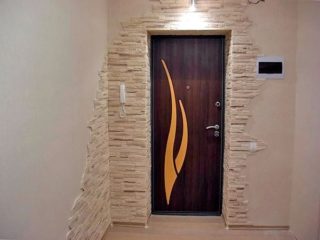
The process of finishing the slopes does not differ from the finishing work in the rooms:
- Laminate and MDF panels are installed on a thin layer of polyurethane foam, which is used to fill the space between the wall and the material.
- The finishing stone is attached to a special resin or liquid nails.
Decorating a doorway with decorative stone has its own characteristics. It is recommended to use plaster with the addition of alabaster. It sticks to the wall more reliably than drywall, which may not support the weight of the finishing material.
Sometimes clinker bricks are used for finishing slopes. In this case, it is advisable to use the same material to decorate the outer corners of that part of the wall where the doorway is located.
Decorating the front door from the inside with your own hands
Before you start finishing the inner surface of the entrance door, in addition to the basic materials, you need to take care of the presence of tools and auxiliary materials.
For high-quality staining of the door you will need:
- paint roller or brush;
- Screwdriver Set;
- ditch (if a paint roller will be used).
Prepare old newspapers or plastic wrap.
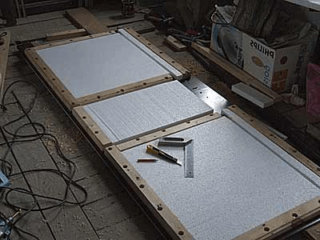
To work on the door upholstery with soft materials, you will need:
- insulation;
- decorative nails (for wooden doors);
- polymer glue;
- decorative wire or fishing line;
- glue brush;
- knife with replaceable blades;
- a set of screwdrivers or a screwdriver with a set of bits;
- pencil;
- roulette;
- a hammer;
- plastic plugs;
- stapler.
Door cladding is carried out using the following tools and materials:
- insulation (if necessary);
- screwdriver with a set of drills and bits;
- primer;
- paint brush;
- roulette;
- a hammer;
- clamps;
- white spirit or acetone;
- sandpaper;
- self-tapping screws;
- glue;
- plastic plugs.

The door leaf is dismantled from the hinges and prepared for finishing work as follows:
- All handles, locks and peephole are removed.
- The surface to be decorated is cleaned with sandpaper and degreased with acetone or white spirit.
- The degreased surface is primed and, if necessary, putty.
The painting of the door is carried out after it has completely dried. Old newspapers or plastic wrap are spread on the floor. On the door leaf, paint is applied with a roller or brush in two, and sometimes in three layers. After the paint has dried, all previously removed fittings are returned to their places.
Upholstery of a door leaf with soft material begins with the manufacture and fastening of rollers (tubes made of upholstery material with a heater wrapped in it). Depending on where the door opens, the rollers are attached to the door leaf or to the door frame.
The formed roller should protrude no more than 3 cm beyond the edge of the door.
Insulation is laid on the door leaf, which should not go over the roller. Further:
- The insulation is attached to the door with a stapler.
- The soft upholstery material is laid on the insulation and its edges are tucked inward by 50-60 mm.
- Decorative nails are driven in at one of the upper corners of the door at a distance of about 7 mm.The second nail is driven into the opposite upper corner. Then the sheathing material is pulled and nails are driven in along the upper edge of the door leaf in increments of 10-12 cm.
- Similarly to item 3, nails are driven in on both sides and at the bottom of the door.
- Cut out holes for the removed fittings and install them in their places.
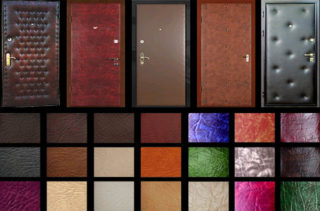
After the upholstery material is fixed, they begin to decorate it. To do this, use a special wire or fishing line.
Sheathing of the inner side of the door leaf with plates of finishing material, cut to the required size, is carried out using an adhesive that is applied to the entire surface of the door. In this case, the composition of the glue depends on the materials to be glued, for example, when sheathing an iron sheet from the inside, liquid nails are used.
Finishing the door with a laminate, the ends of which have an unaesthetic appearance, will require wooden slats painted in the color of the base material. These slats are fastened with self-tapping screws along the entire perimeter of the door leaf. The heads of the self-tapping screws are closed with plastic plugs. In this case, the plate on all sides should have dimensions slightly less than the surface of the door leaf.








